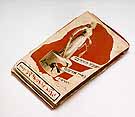
|
|
|

|

|

|

|
|
Click on an image to see a larger, more detailed picture.
|
|
|
|
|
| 1941: Mass Murder |

|
pg. 241 |

|
|
|
|
| |
 Jews of Kovno, Lithuania, move into the ghetto that was established on the third day of the German campaign against the Soviet Union. The rapidly issued orders to relocate created havoc among the Jews of Kovno. The man in this photo is pulling a disassembled wardrobe that he hoped to set up in his new residence. The limited space in the ghetto houses, however, would compel him and other ghetto inhabitants to hang their clothes from nails.
Jews of Kovno, Lithuania, move into the ghetto that was established on the third day of the German campaign against the Soviet Union. The rapidly issued orders to relocate created havoc among the Jews of Kovno. The man in this photo is pulling a disassembled wardrobe that he hoped to set up in his new residence. The limited space in the ghetto houses, however, would compel him and other ghetto inhabitants to hang their clothes from nails.
Photo: George Kadish / United States Holocaust Memorial Museum Photo Archive
|
 Pictured is a compilation of German regulations for the Kovno (Lithuania) Ghetto. The cover of this volume is adorned with the statue of justice holding a scale. The Hebrew title expresses the sardonic Jewish reaction to life under the Nazis: "These are the laws--German style."
Pictured is a compilation of German regulations for the Kovno (Lithuania) Ghetto. The cover of this volume is adorned with the statue of justice holding a scale. The Hebrew title expresses the sardonic Jewish reaction to life under the Nazis: "These are the laws--German style."
Photo: Avraham Tory / United States Holocaust Memorial Museum Photo Archive
|
|
Elchanan Elkes Elchanan Elkes, head of Kovno (Lithuania) Ghetto's Jewish Council, was unlike other ghetto council heads. A Lithuanian physician, Elkes was not a dictatorial leader, but rather an exemplary figure of high moral standards who served his community with integrity and selfless dedication. Elkes left the day-to-day running of ghetto affairs to his deputy. His main function was to intercede with German authorities, who respected him. He worked tirelessly to persuade them to soften harsh decrees. Elkes created work for ghetto residents, and encouraged underground activity that helped many escape to nearby forests. During the ghetto's final days, Elkes desperately tried to convince the SS to spare the surviving Jews, warning them of accountability for their crimes. Unable to halt the murder of the ghetto's population, Elkes wrote: "My soul is scorched. I am naked and empty." Elkes was deported to the Landsberg concentration camp, where he died in 1944.
|
|

|

|

|

|
 July 1941: In the Bialystok region of Poland, Nazis murder 300 members of the Jewish intelligentsia.
July 1941: In the Bialystok region of Poland, Nazis murder 300 members of the Jewish intelligentsia.
|
 July 1941: German killing squads begin to murder Jews remaining in Kishinev, Romania.
July 1941: German killing squads begin to murder Jews remaining in Kishinev, Romania.
|
 July 1941: The Hungarian government undertakes a mass roundup of almost 18,000 Jewish refugees for deportation to Kamenets-Podolski, Ukraine.
July 1941: The Hungarian government undertakes a mass roundup of almost 18,000 Jewish refugees for deportation to Kamenets-Podolski, Ukraine.
|
 July 1941: Twenty-two-year-old Jew Haya Dzienciolski finds a pistol, leaves Novogrudok, Ukraine, and helps to organize a group of young partisans in nearby forests.
July 1941: Twenty-two-year-old Jew Haya Dzienciolski finds a pistol, leaves Novogrudok, Ukraine, and helps to organize a group of young partisans in nearby forests.
|
 July 1, 1941: One hundred Jews are murdered at Lyakhovichi, Belorussia.
July 1, 1941: One hundred Jews are murdered at Lyakhovichi, Belorussia.
|
 July 1, 1941: Hundreds of Jews are killed at Plunge, Lithuania.
July 1, 1941: Hundreds of Jews are killed at Plunge, Lithuania.
|
 July 1-3, 1941: After Germans and Ukrainians spread a rumor that Jews had contributed to the execution of Ukrainian political prisoners, rioting erupts in Lvov, Ukraine. Hundreds of Jews are exterminated by the Nachtigall battalion, a Ukrainian militia directed by the Gestapo.
July 1-3, 1941: After Germans and Ukrainians spread a rumor that Jews had contributed to the execution of Ukrainian political prisoners, rioting erupts in Lvov, Ukraine. Hundreds of Jews are exterminated by the Nachtigall battalion, a Ukrainian militia directed by the Gestapo.
|
 July 1-3, 1941: In the Ukrainian town of Koritz, Nazi troops murder Jews and prepare three burial pits, one each for men, women, and children. For sport, a man's corpse is propped atop one of the pits, in which some Jews have been buried alive.
July 1-3, 1941: In the Ukrainian town of Koritz, Nazi troops murder Jews and prepare three burial pits, one each for men, women, and children. For sport, a man's corpse is propped atop one of the pits, in which some Jews have been buried alive.
|
|
|
|
|
| 1941: Mass Murder |

|
pg. 241 |

|
|
The Holocaust Chronicle
© 2009 Publications International, Ltd.
|
|
